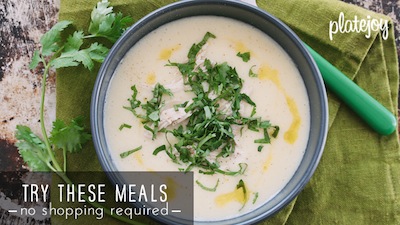There are a few things we just inherently trust:
- parents (excluding years 13 to 22)
- the pythagorean theorem
- weather predications made by groundhogs
- and when it comes to low sodium cooking, nutrition labels
To live a successful (and almost effortless) low sodium lifestyle, one has to be educated. You’ve got to know your stuff.
By reading blogs and books and searching the internet, you will be able to confidently approximate how much sodium is in that piece of celery, that muffin, or that plate of pasta on the menu. Which will enable you to make smart eating decisions quickly, without a pen and paper. And a calculator. And a low sodium food thesaurus. Cause that stuff is a pain to carry around.
But what happens when the information you depend upon, the information you trust, suddenly isn’t so trustworthy?
A few weeks ago, a short post on shrimp-less curry ignited quite an exciting discussion.
Referencing my go-to site for nutritional information – the USDA’s National Nutrient Database – I wrote that shrimp contains 480mg of sodium for 3 ounces. A number which actually surprised me as one of my older reference books, the Pocket Guide to Low Sodium Foods, edited in 2003 and based on the USDA’s numbers, listed shrimp as only containing 144mg of sodium for 3 ounces.
Curious. A bit disconcerting. Definitely a subject that needed further investigating. Especially if readers were going to alter their diet because of it.
Instead of panicking or crying – things that I am trying to do less of these days, along with not eating chocolate for breakfast – I decided to go straight to the source. I wrote the good fellows and ladies of the USDA and asked for an explanation.
Dear USDA staff:
I have to keep a very strict, low sodium diet and I rely on your site for nutritional information. In all the books and sites I’ve ever read, it has said that shrimp contains around 120-140 mg of sodium per 3 oz serving. But on your site, it says raw shrimp (mixed crustacean) has 480 mg of sodium per 3 oz serving. Can you please help clear up this discrepancy?
Thank you so much for your help.
After I sent this letter out into the airwaves, I thought I may never hear back. Does anyone ever answer those general queries?
And then, only a few hours later, the airwaves boomeranged right back, and a little note in my inbox from Jacob proved me wrong.
Thank you for your inquiry regarding the sodium content of shrimp in the NDL database. We recently conducted a nationwide sampling and analysis of about 20 species of finfish and shellfish, including shrimp. The samples were all obtained from retail supermarkets, and they represent what consumers would likely purchase.
The new sodium value is based on this sampling. We are told by the National Fisheries Institute that seafood may come in contact with sodium solutions during their processing. It is likely that this is the reason for the higher sodium values. Our older data were mainly from the scientific literature and would not necessarily represent what is in the marketplace.
I hope this answers your question.
You know what, Jacob? It did. Quickly.
So here are the lessons that I learned:
FIRST, When buying shrimp from your grocery store fish counter, it is hard to know the exact sodium content. Like with poultry – which can be plumped with salt water in order to make it juicier and heavier – the pre-treatment and sodium content will depend on the manufacturer. The only thing you can do to avoid the “salted” versions is to know where your food came from and how it was processed before it reached the store. Or buy it frozen, in a box, with a label. Again, good eating comes down to education and information. And talking to your grocer or fishmonger, a lot. Or learning how to catch shrimp yourself. Which could be a fun, slightly wet, adventure.
And SECOND, simply put, even when you feel you have reached an impasse, there is always a way around it. At the start of this shrimp query, I thought my go-to resource had been proven ineffectual. Which was a real downer. But quickly, my spirits rose and my confidence grew when I found out that, not only was my resource still valuable, but I actually had a direct line to a real person. With answers.
So I hope this helps bring our short story on shrimp to a somewhat satisfying conclusion. It seems that yes, shrimp can be as low as 140mg of sodium per 3 ounce serving – if it isn’t treated with salt water before it reaches the store. Just keep your eyes open, your brains alert, and your mouths talking to pick that right shellfish for your diet.
And if you have any other questions, now you know you can always just ask.
Chow on. Wisely.








I can’t wait to talk with the owner of my favorite fish market. Thanks for all the info. Shrimp had me baffled…
nice investigative journaling SG. another mystery solved.
Good to know! We’re having shrimp alfredo tonight. Oh, and chocolate for breakfast?? What kinda nut does that? (answer = me)
Good to hear all that. We noticed recently when we cooked shrimp that it was very salty – not like in the past. So, the last time we had some, my husband soaked it for a long time in cold water with several changes to get the sodium out by osmosis so I could eat it!
Great sleuthing Sodium Girl! It does prove that it is good to use many resources and to be vigilant. I tasted a couple of cold boiled shrimp at a party last night and WOW – serious salt! Isn’t it funny how your taste buds kick in when you are aware. Keep up the great work!
Thanks for this! Especially the link to the USDA’s db. Great resource.
I’d already taken to buying my shrimp frozen raw, in bags with nutritional information so I can at least know how much is in it. My store brand (in TX) is decent, closer to your original numbers than the new revised numbers.
A great message about staying up to date on food processing and knowing that we can rely on the USDA. Great post, thanks!
My husband now has to have a low sodium diet and we love shrimp. Your post was great and just what I have been looking for. We live in Florida so we eat river, locally caught shrimp, which we find (and so do all my friends and family in CA)much more tender and sweet. A little helpful hint that someone may be able to use: when shrimp smell strong or have a strong iodine taste, soak in milk for about 30 -45 minutes before preparing. Takes care of that! I wonder if perhaps you could research and find out if river shrimp have less sodium than ocean shrimp. I’m one of those elderly who are not good with the computer. Thanks again. Karen Long, Jacksonville, Fl
That’s a great question, Karen! I’ll look into this!
Is it possible to get sodium out of processed meats. I just bought turkey kielbasa I looked at the sodium and 740 grm per svg
Thanks
When it comes to processed meat products, there’s no way to “get the salt out” other than to make it from scratch. Meaning: salt-free kielbasa is officially on my salt-free to-do list! Thanks for the idea!
For low sodium shrimp, eat only fresh caught shrimp or read the label. Its not the salt water that adds the sodium, its a preservative called sodium polyphosphate that is added to most frozen and processed seafood. They add this in varied amounts so read the label. Fresh caught shrimp have only 125 mg per 3 oz.
Thanks so much for the info!!!. I was going to also ask the USDA about the confusing differences in reported sodium levels and your posting saved me the time and effort.
My recent purchase of frozen shrimp was slightly lower – 460 mg for 3 oz.
Until I retired, I worked in research in the food industry for some decades. Part of my experience was the development of packaging nutritional labels. You HAVE to use the USDA numbers in calculating the nutritional content. I believe they do an excellent job in developing the averages across the food chain.
No individual company, even the largest, can analyze incoming raw materials for their complete nutritional profile … huge expense … and if it differs from the USDA levels you have a legal risk. You would have to repeat the analysis every time there is a new crop since nutrients differ each crop season … never mind local conditions. If the company is making a specific nutritional “claim” then they will have to do very extensive and ongoing testing to confirm the claim.
I agree with the suggestion earlier to check package labels of frozen shrimp. However, some may be using the old data base of it being lower, so I plan to soak my thawed shrimp for several hours to reduce the sodium content.
Okay Ladies….what does 3 oz of shrimp constitute…1 shrimp? 2?3? Help! 🙂 Thank you.
On the package I have a 50-70 count per pound, probably small to medium size a 3oz serving is 11 shrimp. This brand from Costco has 250 mg’s of sodium. Thanks for clarifying the sodium content discrepancies . Glad I found this site.
thanks for all the info about shrimp/learned a lot
Great article! Thanks, just what I needed to know! 🙂
I have heard you can decrease the salt content by soaking frozen fish and or shrimp in water do you know this to be true frozen fish and shrimp are much more economical to purchase but have a high sodium content do you have any other suggestions to reduce the sodium content if soaking in water doesn’t do it
I live in Northwestern Montana in the summer and Arizona in the winter. Being close to Algodones Mexico, I buy my shrimp fresh from the sea of Cortez. (no added sodium phosphate) If you live along the ocean or within a closer distance, buy your shrimp from local shrimpers, its fresher, cheaper, and the big plus of No Added Sodium.
Just looked into this, I was horrified last night when I purchased a bag of raw frozen deveined shrimp the sodium content being 1096 mg in a serving of 6 prices!!! I’m wondering how much of that can be rinced off or cooked out!?